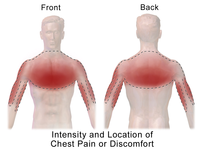
Photo from wikipedia
Background: Acute pain is one of the most commonly cited reasons for attendance to the emergency department (ED), and the Royal College of Emergency Medicine (RCEM) Best Practice Guideline (2014)… Click to show full abstract
Background: Acute pain is one of the most commonly cited reasons for attendance to the emergency department (ED), and the Royal College of Emergency Medicine (RCEM) Best Practice Guideline (2014) acknowledged that the current management of acute pain in UK EDs is inadequate and has a poor evidence base. Methods: The Prescription Of analgesia in Emergency Medicine (POEM) survey is a cross-sectional observational survey of consecutive patients presenting to 12 National Health Service (NHS) EDs with limb fracture and/or dislocation in England and Scotland and was carried out between 2015 and 2017. The primary outcome was to assess the adequacy of pain management in the ED against the recommendations in the RCEM Best Practice Guidelines. Results: In all, 8346 patients were identified as attending the ED with a limb fracture and/or dislocation but adherence to RCEM guidelines could only be evaluated for the 4160 (49.8%) patients with a recorded pain score. Of these, 2409/4160 (57.9%) patients received appropriate pain relief, but only 1347 patients were also assessed within 20 minutes of their arrival in the ED. Therefore, according to the RCEM guidelines, only 16.1% (1347/8346) of all patients were assessed and had satisfactory pain management in the ED. Conclusions: The POEM survey has identified that pain relief for patients with an isolated limb fracture remains inadequate when strictly compared to the RCEM Best Practice Guidelines. However, we have found that some patients receive analgesia despite having no pain score recorded, while other analgesic modalities are provided that are not currently encompassed by the Best Practice Guidelines. Future iterations of these guidelines may wish to encompass the breadth of available modalities of pain relief and the whole patient journey. In addition, more work is needed to improve timely and repeated assessment of pain and its recording, which has been better achieved in some EDs than others.
Journal Title: British Journal of Pain
Year Published: 2020
Link to full text (if available)
Share on Social Media: Sign Up to like & get
recommendations!